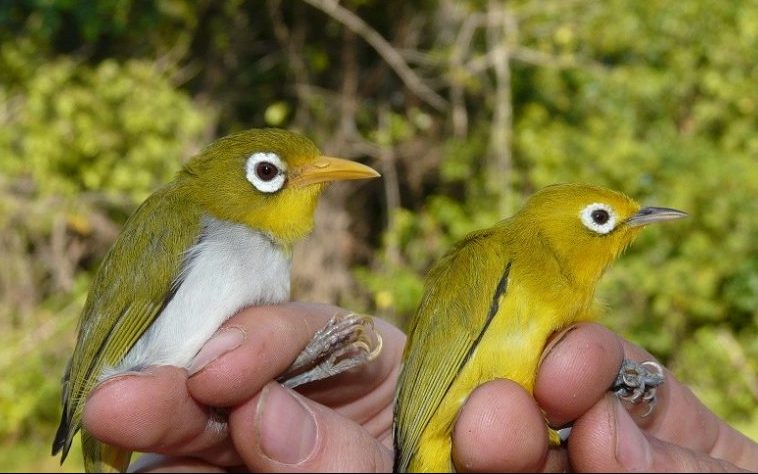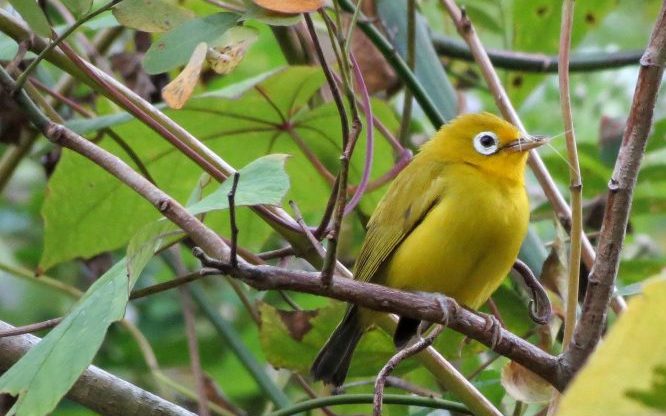Two new species of white-eye have been identified from the Wakatobi Archipelago of Sulawesi, Indonesia.
The birds were assessed by zoologists from Trinity College Dublin, working with partners from Halu Oleo University (UHO) and Operation Wallacea, with the research shedding more light on the complex evolutionary puzzle of how new species emerge.
The two species, which have been dubbed Wakatobi White-eye and Wangi-wangi White-eye, have been detailed in research published on 24 April in the prestigious Zoological Journal of the Linnean Society – the same publication in which Alfred Wallace and Charles Darwin published their original theories about speciation in 1858.

Wangi-wangi (left) and Wakatobi White-eyes in the hand (Nicola Marples and David Kelly).
The group of scientists, led by Professor Nicola Marples at Trinity's School of Natural Sciences, has been studying birds on Sulawesi, Indonesia, and its offshore islands since 1999. Sulawesi, which lies in the middle of Indonesia, is known for its unusual flora and fauna and boasts an unusually high number of endemic species due to the deep ocean trenches either side of it that isolate it from other landmasses – even during past ice ages when ocean levels dropped.
Using a modern research approach to the question of species separation, the Trinity team incorporated genetic, body size and song measures as a means of comparing organisms. Differences in bird song are particularly important as birds use their vocalisations to attract mates.
As a family, white-eyes have spread and speciated more rapidly than any other birds. They are adaptable, feeding on a wide variety of fruits, flowers and insects. White-eyes are also supreme island colonisers, which is why so many different white-eye species have evolved so rapidly, as separate populations become isolated and split off from their sources.
The two new white-eye species 'discovered' by Trinity and UHO follow this trend. They are both found on the Wakatobi Islands, just off the south-east of mainland Sulawesi. However, the two species are very different.
Wakatobi White-eye has been subject of the species debate for some time, but the research has demonstrated that is should be split from Lemon-bellied White-eye. In contrast, Wangi-wangi White-eye remained unnoticed until the beginning of the 21st century, when Professor Marples's research group visited the island from which it takes its name. However, with the research group having not collected a type specimen, it remains formally undescribed as a Zosterops sp for the time being.

Wakatobi White-eye in the field (Seán Kelly).
Wakatobi White-eye is found throughout the Wakatobi Islands and split from its mainland relatives in the last 800,000 years. Wangi-wangi White-eye is a much older species found on just one small island, with its closest relatives found more than 1,900 miles away. While this is an incredible discovery, having such an isolated and small range makes it particularly susceptible to extinction through habitat loss.
Lead author of the journal article, Dr Darren O'Connell, who recently completed his PhD in Trinity's School of Natural Sciences and is now working at University College Dublin, explained: "These discoveries are not just of evolutionary interest – they will also be of real conservation relevance. By highlighting the unique species special to the Wakatobi Islands we can help safeguard the remaining habitats on the islands, which are under huge pressure. We ultimately hope to have the islands recognised as an Endemic Bird Area so that they receive more conservation support."
Reference
O'Connell, D P, Kelly, D J, Lawless, N, O'Brien, K, Ó Marcaigh, F, Karya, A, Analuddin, K, and Marples, N M. 2019. A sympatric pair of undescribed white-eye species (Aves: Zosteropidae: Zosterops) with different origins. Zoological Journal of the Linnean Society. DOI: https://doi.org/10.1093/zoolinnean/zlz022

